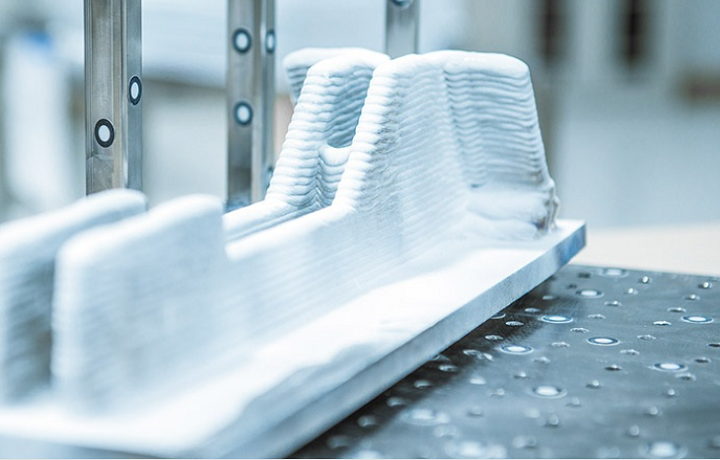Additive manufacturing company Norsk Titanium US Inc. (Norsk) specializes in structural, aerospace-grade titanium components, and was actually the first to have its 3D printed titanium structural components approved by the Federal Aviation Administration to be used in a commercial airplane, the Boeing Dreamliner, back in 2017. Now, the company has announced production deliveries of new 3D printed components for the Boeing 787 Dreamliner to Leonardo’s South Italy-based Grottaglie Plant, which is part of its Aerostructures Division.
These new Boeing parts were made using Norsk’s patented Rapid Plasma Deposition (RPD) AM process, which it publicly unveiled to the world in 2015. The proprietary technology, which I’ve seen called both a plasma arc method and a DED one, uses an environment of inert gas, such as argon, to melt titanium wire. Then, just like other 3D printing technologies, the heated material is built up quickly in subsequent layers to make the final, near-net-shape part. To ensure accuracy, the RPD process is monitored more than 600 times per second for quality assurance purposes.
Norsk has long put a heavy focus on metallurgy. While other metal materials, including nickel alloys, tool steel, and stainless steel, can all work with the RPD platform, the company—a Tier 1 Supplier to Commercial Airframe and Engine OEMs and a popular partner for aerospace companies—most often uses titanium wire, in order to meet the many exacting requirements of the highly regulated aerospace sector.
RPD printing is said to make the process flow simpler, as well as being able to produce stronger, more durable. Additionally, according to the Norsk website, RPD results in “significantly less machining” than is required for conventional, forge-based methods of manufacturing, which can lead to a major improvement of 50-75% in the buy-to-fly ratio…very helpful in on-demand environments like aerospace that produce safety-critical and structural components.
“Reduced machining also leads to less tooling and energy usage, which are significant cost drivers for titanium parts. The end result is reduced production cost for finish titanium parts, ultimately benefiting the customer,” the website continues.
This newly announced delivery is now the company’s third production customer in the commercial aerostructure space. Additionally, it is also representative of the first recurring order from an aerospace company based in the European Union for Norsk.
“We are pleased to be Leonardo’s supplier. This delivery marks a significant increase in the number of additively manufactured parts previously manufactured from titanium plate. It also is an important step towards our mission to provide an alternative to titanium forgings in aerospace applications,” Karl Fossum, director of customer programs for Norsk, said about the delivery.
Norsk used its industrial RPD process to design and 3D print preforms out of Ti-6Al-4V, a common titanium alloy with great corrosion resistance. By using Rapid Plasma Deposition, the company was able to achieve a more than 40% reduction of raw material needs, as well as maintaining the necessary material properties and process control.
(Images: Norsk Titanium)
Subscribe to Our Email Newsletter
Stay up-to-date on all the latest news from the 3D printing industry and receive information and offers from third party vendors.
You May Also Like
Profiling a Construction 3D Printing Pioneer: US Army Corps of Engineers’ Megan Kreiger
The world of construction 3D printing is still so new that the true experts can probably be counted on two hands. Among them is Megan Kreiger, Portfolio Manager of Additive...
US Army Corps of Engineers Taps Lincoln Electric & Eaton for Largest 3D Printed US Civil Works Part
The Soo Locks sit on the US-Canadian border, enabling maritime travel between Lake Superior and Lake Huron, from which ships can reach the rest of the Great Lakes. Crafts carrying...
Construction 3D Printing CEO Reflects on Being Female in Construction
Natalie Wadley, CEO of ChangeMaker3D, could hear the words of her daughter sitting next to her resounding in her head. “Mum, MUM, you’ve won!” Wadley had just won the prestigious...
1Print to Commercialize 3D Printed Coastal Resilience Solutions
1Print, a company that specializes in deploying additive construction (AC) for infrastructure projects, has entered an agreement with the University of Miami (UM) to accelerate commercialization of the SEAHIVE shoreline...
































